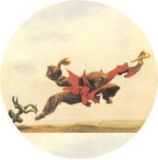
Contents ||| Study Tools |||
Classical Literature ||| Contact |||
Blog
Do I need to explore human history, and how?
Emerson: Art and history as a private and universal adventure
From: Ralph Waldo Emerson, Essays, I: History
Page 3
By simply throwing ourselves into new circumstances we do continually invent anew the orders and the ornaments of architecture, as we see how each people merely decorated its primitive abodes. The Doric temple still presents the semblance of the wooden cabin in which the Dorian dwelt. The Chinese pagoda is plainly a Tartar tent. The Indian and Egyptian temples still betray the mounds and subterranean houses of their forefathers. "The custom of making houses and tombs in the living rock," (says Heeren, in his Researches on the Ethiopians) "determined very naturally the principal character of the Nubian Egyptian architecture to the colossal form which it assumed. In these caverns already prepared by nature, the eye was accustomed to dwell on huge shapes and masses, so that when art came to the assistance of nature, it could not move on a small scale without degrading itself. What would statues of the usual size, or neat porches and wings have been, associated with those gigantic halls before which only Colossi would sit as watchmen, or lean on the pillars of the interior?"
The Gothic church plainly originated in a rude adaptation of the forest trees with all their boughs to a festal or solemn arcade, as the bands about the cleft pillars still indicate the green withes that tied them. No one can walk in a road cut through pine woods, without being struck with the architectural appearance of the grove, especially in winter, when the bareness of all other trees shows the low arch of the Saxons. In the woods in a winter afternoon one will see as readily the origin of the stained glass window with which the Gothic cathedrals are adorned, in the colors of the western sky seen through the bare and crossing branches of the forest. Nor can any lover of nature enter the old piles of Oxford and the English cathedrals without feeling that the forest overpowered the mind of the builder, and that his chisel, his saw, and plane still reproduced its ferns its spikes of flowers, its locust, its pine, its oak, its fir, its spruce.
The Gothic cathedral is a blossoming in stone subdued by the insatiable demand of harmony in man. The mountain of granite blooms into an eternal flower with the lightness and delicate finish as well as the aerial proportions and perspective of vegetable beauty.
Cf. Rilke, Letter to a Young Poet | Plato, Whom are we talking to? | Kierkegaard, My work as an author | Emerson, Self-knowledge | Gibson - McRury, Discovering one's face | Emerson, We differ in art, not in wisdom | Joyce, Portrait of the Artist